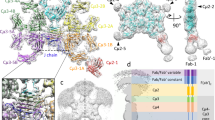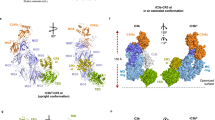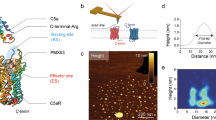Abstract
The complement system in the blood of vertebrates1,2 has a vital role in the defence of the body against invading foreign material. Although it can be triggered before immunity has developed, it is usually activated following an initial intervention by antibodies, and about 20 serum proteins are involved. Some of these act as controlling inhibitors while others form nine components which, if following the classical activation pathway, all take part in bringing about membrane damage and cell lysis. The first component C1 consists of three subcomponents, C1q, C1r and C1s. C1q binds to antibody–antigen complexes as the first stage of fixation3 and as it shows no enzymatic activity by itself, conformational changes on binding have been proposed as the driving mechanism of the subsequent reactions. Since structural investigation by electron microscopy4–7 leaves doubt as to whether unnatural constraints were applied in the preparation and treatment of specimens, techniques such as X-ray or neutron small-angle scattering, which investigate the equilibrium state in dilute solution, provide valuable complementary evidence for both its findings and those of other physicochemical methods8. We have already carried out neutron work on the conformation of immunoglobulin and the influence of hapten binding (to be published) and are now studying the conformation of C1q as a preliminary to investigating the composite structures resulting from their mutual interaction. As evidence of the structure of this molecule has accumulated, the question has arisen of whether it maintains a compact closed conformation in its native state or a more open one in readiness for interaction with other proteins. The neutron small angle scattering curve is sensitive to conformational changes and although our measurements are not yet complete, model calculations suggest that the structural arrangement is indeed open.
This is a preview of subscription content, access via your institution
Access options
Subscribe to this journal
Receive 51 print issues and online access
$199.00 per year
only $3.90 per issue
Buy this article
- Purchase on Springer Link
- Instant access to full article PDF
Prices may be subject to local taxes which are calculated during checkout
Similar content being viewed by others
References
Müller-Eberhard, H. J. A. Rev. Biochem. 44, 697–724 (1975).
Porter, R. R. & Reid, K. B. M. Nature 275, 699–704 (1978).
Müller-Eberhard, H. J. & Kunkel, H. G. Proc. Soc. exp. Biol. Med. 106, 291–295 (1961).
Green, N. M. Adv. Immun. 11, 1–30 (1969).
Shelton, E., Yonemasu, K. & Stroud, R. M. Proc. natn. Acad. Sci. U.S.A. 69, 65–68 (1972).
Svehag, S.-E., Manhem, L. & Bloth, B. Nature new Biol. 238, 117–118 (1972).
Knobel, H. R., Villager, W. & Isliker, H. Eur. J. Immun. 5, 78–81 (1975).
Metzger, H. Adv. Immun. 18, 169–207 (1974).
Reid, K. B. M., Lowe, D. M. & Porter, R. R. Biochem. J. 130, 749–763 (1972).
Jacrot, B. Rep. Prog. Phys. 39, 911–953 (1976).
Schmatz, W., Springer, T., Schelten, J. & Ibel, K. J. appl. Crystallogr. 7, 96–116 (1974).
Ibel, K. J. appl. Crystallogr. 9, 630–643 (1976).
Guinier, A. Annls Phys. 12, 161–237 (1939).
Ibel, K. & Stuhrmann, H. B. J. molec. Biol. 93, 255–265 (1975).
Reid, K. B. M. & Porter, R. R. Biochem. J. 155, 19–23 (1976).
Brodsky-Doyle, B., Leonard, K. R. & Reid, K. B. M. Biochem. J. 159, 279–286 (1976).
Reid, K. B. M. Biochem. J. 161, 247–251 (1977).
Kehoe, J. M., Bourgois, A., Capra, J. D. & Fougerau, M. Biochemistry 13, 2499–2504 (1974).
Yasmeen, D., Ellerson, T. R., Dorrington, K. J. & Painter, R. H. J. Immun. 116, 518–526 (1976).
Mizuochi, T., Yonemasu, K., Yomashita, K. & Kobata, A. J. biol. Chem. 253, 7404–7409 (1979).
Reid, K. B. M. Biochem. J. 155, 5–17 (1976).
Guinier, A. & Fournet, G. in Small-angle Scattering of X-rays (Wiley, New York, 1955).
Pilz, I. in Physical Principles and Techniques of Protein Chemistry Part C (ed. Leach, S.) 141–243 (Academic, New York, 1973).
Reid, K. B. M. & Thompson, E. O. P. Biochem. J. 173, 863–868 (1978).
Author information
Authors and Affiliations
Rights and permissions
About this article
Cite this article
Gilmour, S., Randall, J., Willan, K. et al. The conformation of subcomponent C1q of the first component of human complement. Nature 285, 512–514 (1980). https://doi.org/10.1038/285512a0
Received:
Accepted:
Issue Date:
DOI: https://doi.org/10.1038/285512a0
Comments
By submitting a comment you agree to abide by our Terms and Community Guidelines. If you find something abusive or that does not comply with our terms or guidelines please flag it as inappropriate.



